Python有很多可视化工具,本篇只介绍Matplotlib和Seaborn。
Matplotlib
针对python不显示汉字解决方案
import matplotlib.pyplot as plt
plt.rcParams['font.sans-serif']=['SimHei']
- 在绘图结构中,figure创建窗口,subplot创建子图。
- 所有的绘画只能在子图上进行。plt表示当前子图,若没有就创建一个子图。
- Figure:面板(图),matplotlib中的所有图像都是位于figure对象中,一个图像只能有一个figure对象。
- Subplot:子图,figure对象下创建一个或多个subplot对象(即axes)用于绘制图像。
配置参数
- figure: 控制dpi、边界颜色、图形大小、和子区( subplot)设置
- font: 字体集(font family)、字体大小和样式设置
- grid: 设置网格颜色和线性
- legend: 设置图例和其中的文本的显示
- line: 设置线条(颜色、线型、宽度等)和标记
- savefig: 可以对保存的图形进行单独设置。例如,设置渲染的文件的背景为白色。
- xticks和yticks: 为x,y轴的主刻度和次刻度设置颜色、大小、方向,以及标签大小。
线条相关属性标记设置
- 线形:linestyle或ls
- '-' : 实线
- '--' : 虚线
- 'None',' ','' : 什么都不画
- '-.' : 点划线
- 点型:maker
- 'o' :圆圈
- '.' :点
- 'D' :菱形
- 's' :正方形
- 'h' :六边形1
- '*' :星号
- 'H' :六边形2
- 'd' :小菱形
- '_' :水平线
- 'v' :一角朝下的三角形
- '8' :八边形
- '<' :一角朝左的三角形
- 'p' :五边形
- '>' :一角朝右的三角形
- ',' :像素
- '^' :一角朝上的三角形
- '+' :加号
- '' :竖线
- 'None',' ','' : 无
- 'x' :X
颜色:
b:蓝色 g:绿色 r:红色 y:黄色 c:青色 k:黑色 m:洋红色 w:白色线图 plot()
import numpy as np
import matplotlib.pyplot as plt
plt.rcParams['font.sans-serif'] = ['SimHei'] # 解决中文显示问题-设置字体为黑体
plt.rcParams['axes.unicode_minus'] = False # 解决保存图像是负号'-'显示为方块的问题
x = np.arange(-2*np.pi, 2*np.pi, 0.01)
y1 = np.sin(x)
y2 = np.cos(x)
plt.figure(figsize=(10, 7))
plt.plot(x, y1 ,'r-',label='$sinx$')
plt.plot(x, y2 ,'b--',label='$cosx$')
plt.legend(loc='upper right')
plt.xlim(-2*np.pi-1, 2*np.pi+3)
plt.xticks([-2*np.pi, -np.pi, 0, np.pi, 2*np.pi], ['$-2\pi$', '$-\pi$', '$0$', '$\pi$', '$2\pi$'])
plt.title('三角-函数')
plt.xlabel('横坐标')
plt.ylabel('纵坐标')
plt.axhline(y=0, c='black')
plt.show()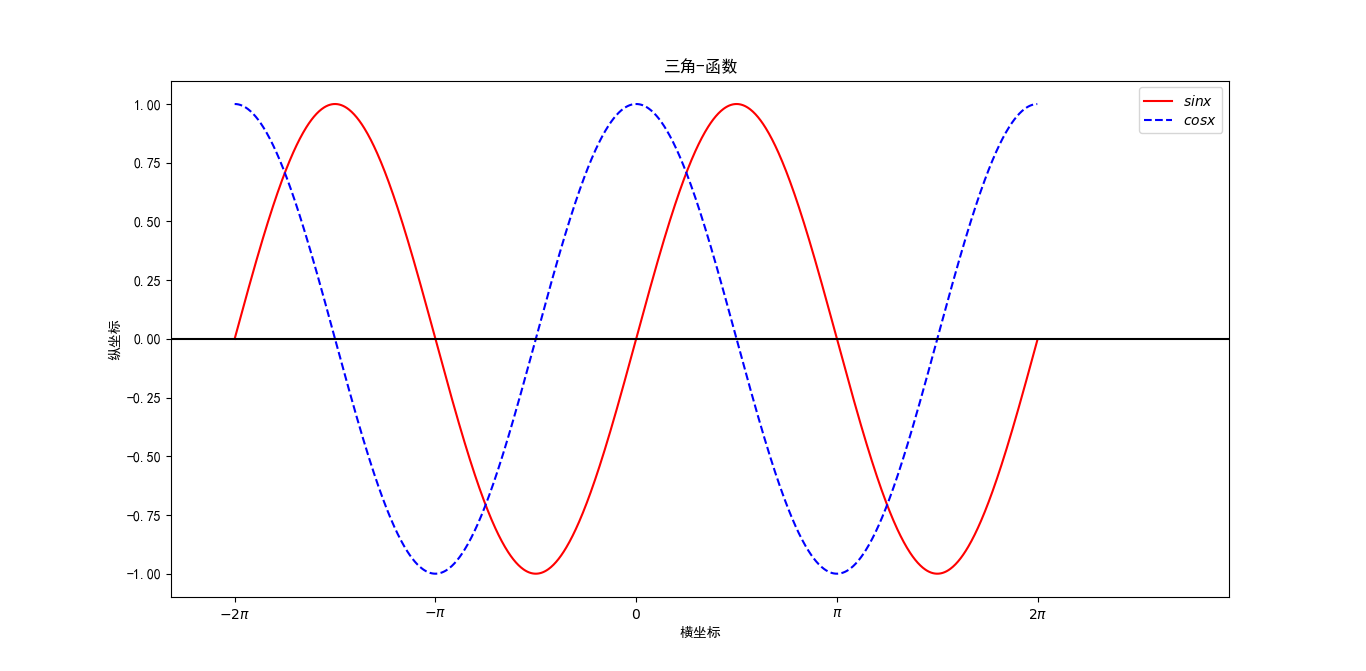
plot()参数
- plot([x], y, [fmt], data=None, **kwargs)
- 可选参数[fmt] 是一个字符串来定义图的基本属性如:颜色(color),点型(marker),线型(linestyle),
- 具体形式 fmt = 'color[line]'
- fmt接收的是每个属性的单个字母缩写,例如:
- plot(x, y, 'bo-') # 蓝色圆点实线
散点图
# 散点图
import matplotlib.pyplot as plt
plt.rcParams['font.sans-serif']=['SimHei'] #显示中文
fig = plt.figure(figsize=(6,5))
x = [1.5, 1, 1, 2, 2, 3, 3, 4, 4, 5, 5]
y = [6, 7, 8, 5, 9, 4, 9.5, 3, 9.5, 2, 9]
x1 = [6, 6, 7, 7, 8, 8, 9, 9, 10, 10, 10.5, 11, 11]
y1 = [1, 8, 2, 9, 3, 9, 4, 9.5, 5, 9, 6, 7, 8]
plt.scatter(x, y, color='r', label='左心房')
plt.scatter(x1, y1, color='b', label='右心房')
plt.title('love')
plt.legend()
plt.show()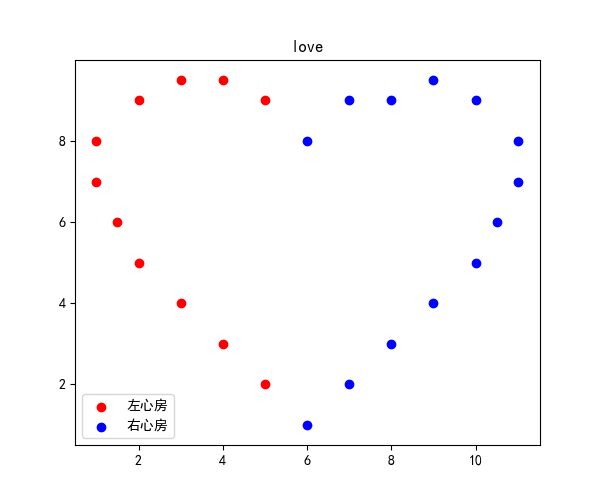
条形图
import matplotlib
import matplotlib.pyplot as plt
import numpy as np
labels = ['Monday','Tuesday','Friday','Sunday']
men_means = [1.5,0.6,7.8,6]
women_means = [1,2,3,1]
x = np.arange(len(labels)) # the label locations
width = 0.35 # the width of the bars
fig, ax = plt.subplots()
rects1 = ax.bar(x - width/2, men_means, width, label='boy')
rects2 = ax.bar(x + width/2, women_means, width, label='girl')
# Add some text for labels, title and custom x-axis tick labels, etc.
ax.set_ylabel('Scores') #标题
ax.set_title('Scores by group and gender') #标题
ax.set_xticks(x)
ax.set_xticklabels(labels)
ax.legend()
def autolabel(rects):
"""Attach a text label above each bar in *rects*, displaying its height."""
for rect in rects:
height = rect.get_height()
ax.annotate('{}'.format(height),
xy=(rect.get_x() + rect.get_width() / 2, height),
xytext=(0, 3), # 3 points vertical offset
textcoords="offset points",
ha='center', va='bottom')
autolabel(rects1)
autolabel(rects2)
fig.tight_layout()
plt.show()

import matplotlib
import matplotlib.pyplot as plt
import numpy as np
labels = ['Monday','Tuesday','Friday']
men_means = [1.5,0.6,7]
women_means = [1,2,3]
child=[1,1,2]
x = np.arange(len(labels)) # the label locations
width = 0.35 # the width of the bars
fig, ax = plt.subplots()
rects1 = ax.bar(x - 3*width/4, men_means, 3*width/4, label='boy')
rects2 = ax.bar(x, women_means,3*width/4, label='girl')
rects3 = ax.bar(x + 3*width/4, child, 3*width/4, label='child')
# Add some text for labels, title and custom x-axis tick labels, etc.
ax.set_ylabel('Scores') #标题
ax.set_title('Scores by group and gender') #标题
ax.set_xticks(x)
ax.set_xticklabels(labels)
ax.legend()
def autolabel(rects):
"""Attach a text label above each bar in *rects*, displaying its height."""
for rect in rects:
height = rect.get_height()
ax.annotate('{}'.format(height),
xy=(rect.get_x() + rect.get_width() / 2, height),
xytext=(0, 3), # 3 points vertical offset
textcoords="offset points",
ha='center', va='bottom')
autolabel(rects1)
autolabel(rects2)
autolabel(rects3)
fig.tight_layout()
plt.show()
直方图
直方图与条形图基本类似,不过直方图通常用来对单个数据的单一属性进行描述,而不是用于比较
- data:必选参数,绘图数据
- bins:直方图的长条形数目,可选项,默认为10 normed:是否将得到的直方图向量归一化,可选项,默认为0,代表不归一化,显示频数。normed=1,表示归一化,显示频率。
- facecolor:长条形的颜色
- edgecolor:长条形边框的颜色
- alpha:透明度
import matplotlib.pyplot as plt
plt.rcParams['font.sans-serif'] = ['SimHei'] # 中文显示
plt.rcParams['axes.unicode_minus']=False # 正常显示负号
import numpy as np
data = np.random.randn(10000)
plt.hist(data, bins=40, normed=0, facecolor='blue', edgecolor='black', alpha=0.7)
plt.xlabel('区间')
plt.ylabel('频数')
plt.title('频数分布直方图')
plt.show()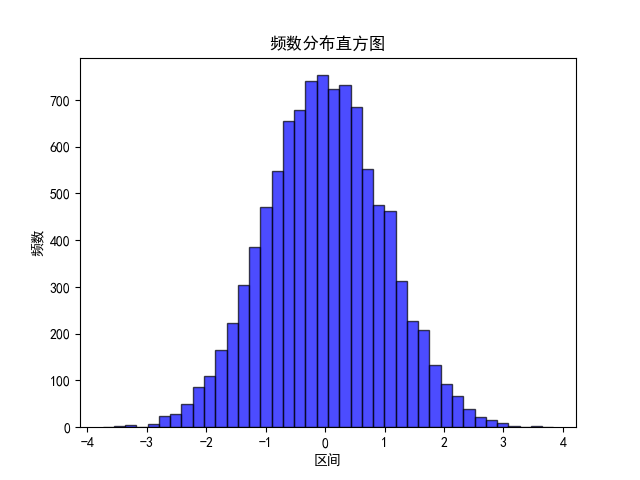
饼图
- x :(每一块)的比例,如果sum(x) > 1会使用sum(x)归一化;
- labels :(每一块)饼图外侧显示的说明文字;
- explode :(每一块)离开中心距离;
- startangle :起始绘制角度,默认图是从x轴正方向逆时针画起,如设定=90则从y轴正方向画起;
- shadow :在饼图下面画一个阴影。默认值:False,即不画阴影;
- autopct :控制饼图内百分比设置,可以使用format字符串或者format function '%1.1f'指小数点前后位数(没有用空格补齐);
import matplotlib.pyplot as plt
plt.rcParams['font.sans-serif'] = ['SimHei'] # 中文显示
plt.rcParams['axes.unicode_minus']=False # 正常显示负号
labels = ['育儿','饮食','房贷','其他']
x = [5,12,50,9]
explode = (0,0,0.01,0) #0.01调整中间空格大小
plt.pie(x,labels=labels,explode=explode,autopct='%1.1f%%')
plt.title('家庭支出比例')
plt.show()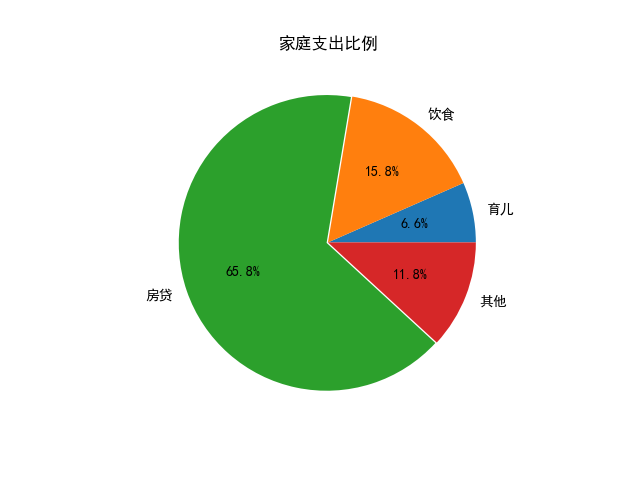
import numpy as np
import matplotlib.pyplot as plt
fig, ax = plt.subplots(figsize=(6, 3), subplot_kw=dict(aspect="equal"))
recipe = ["375 g flour",
"75 g sugar",
"250 g butter",
"300 g berries"]
data = [float(x.split()[0]) for x in recipe]
ingredients = [x.split()[-1] for x in recipe]
def func(pct, allvals):
absolute = int(pct/100.*np.sum(allvals))
return "{:.1f}%\n({:d} g)".format(pct, absolute)
wedges, texts, autotexts = ax.pie(data, autopct=lambda pct: func(pct, data),
textprops=dict(color="w"))
ax.legend(wedges, ingredients,
title="Ingredients",
loc="center left",
bbox_to_anchor=(1, 0, 0.5, 1))
plt.setp(autotexts, size=8, weight="bold")
ax.set_title("Matplotlib bakery: A pie")
plt.show()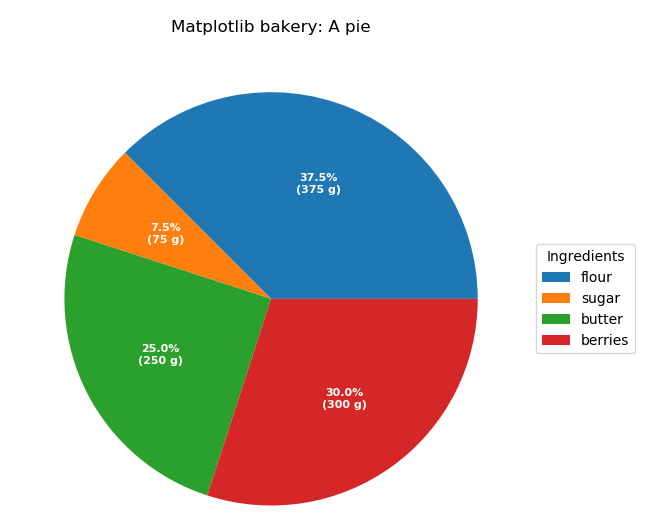
import numpy as np
import matplotlib.pyplot as plt
fig, ax = plt.subplots(figsize=(6, 3), subplot_kw=dict(aspect="equal"))
recipe = ["225 g flour",
"90 g sugar",
"1 egg",
"60 g butter",
"100 ml milk",
"1/2 package of yeast"]
data = [225, 90, 50, 60, 100, 5]
wedges, texts = ax.pie(data, wedgeprops=dict(width=0.5), startangle=-40)
bbox_props = dict(boxstyle="square,pad=0.3", fc="w", ec="k", lw=0.72)
kw = dict(arrowprops=dict(arrowstyle="-"),
bbox=bbox_props, zorder=0, va="center")
for i, p in enumerate(wedges):
ang = (p.theta2 - p.theta1)/2. + p.theta1
y = np.sin(np.deg2rad(ang))
x = np.cos(np.deg2rad(ang))
horizontalalignment = {-1: "right", 1: "left"}[int(np.sign(x))]
connectionstyle = "angle,angleA=0,angleB={}".format(ang)
kw["arrowprops"].update({"connectionstyle": connectionstyle})
ax.annotate(recipe[i], xy=(x, y), xytext=(1.35*np.sign(x), 1.4*y),
horizontalalignment=horizontalalignment, **kw)
ax.set_title("Matplotlib bakery: A donut")
plt.show()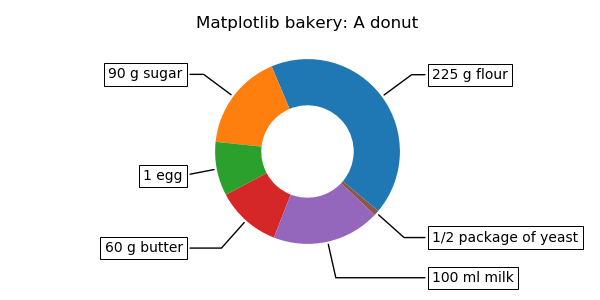
Seaborn
线图plot()
import numpy as np
import matplotlib.pyplot as plt
import seaborn as sns
plt.rcParams['font.sans-serif'] = ['SimHei'] # 中文字体设置-黑体
plt.rcParams['axes.unicode_minus'] = False # 解决保存图像是负号'-'显示为方块的问题
sns.set(font='SimHei') # 解决Seaborn中文显示问题
x = np.arange(-2*np.pi, 2*np.pi, 0.01)
y1 = np.sin(x)
y2 = np.cos(x)
plt.figure(figsize=(10, 7))
plt.plot(x, y1,'r-',label='$sinx$')
plt.plot(x, y2,'b--',label='$cosx$')
plt.legend(loc='upper right')
plt.xlim(-2*np.pi-1, 2*np.pi+3)
plt.xticks([-2*np.pi, -np.pi, 0, np.pi, 2*np.pi], ['$-2\pi$', '$-\pi$', '$0$', '$\pi$', '$2\pi$'])
plt.title('三角-函数')
plt.xlabel('横坐标')
plt.ylabel('纵坐标')
plt.axhline(y=0, c='black')
plt.show()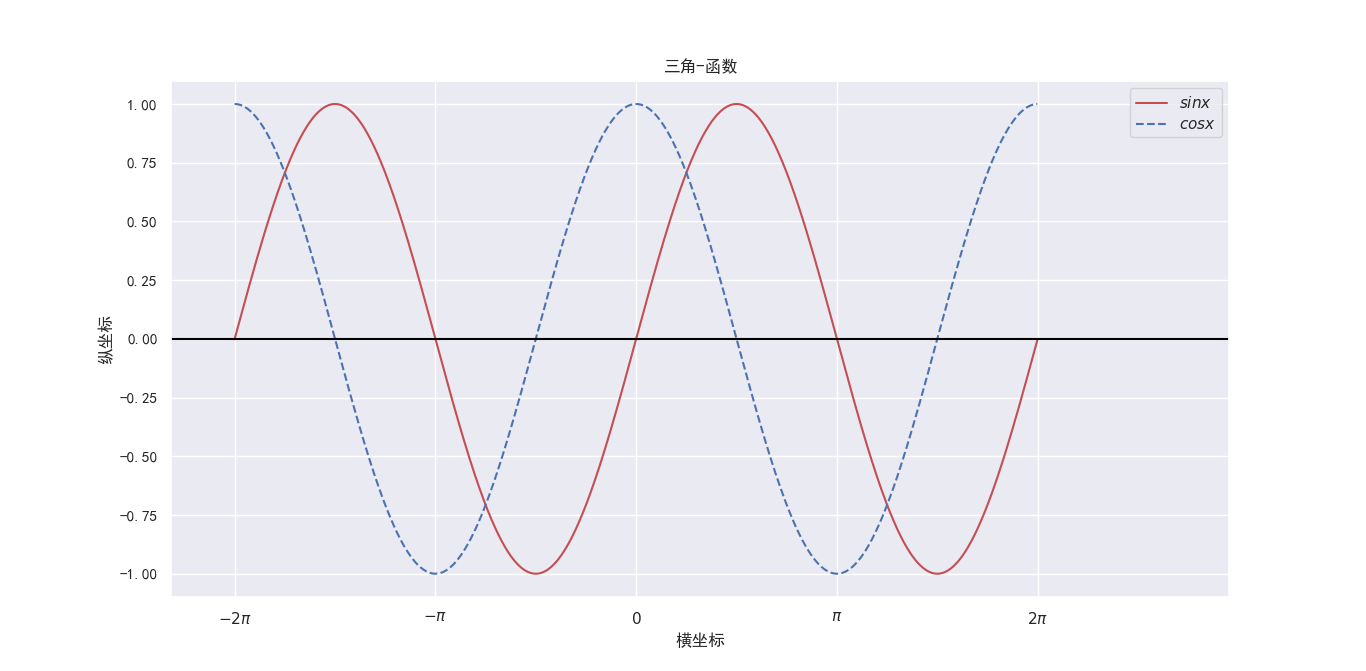
直方图
import numpy as np
import matplotlib.pyplot as plt
import seaborn as sns
plt.rcParams['font.sans-serif'] = ['SimHei'] # 中文显示
plt.rcParams['axes.unicode_minus']=False # 正常显示负号
sns.set(font='SimHei') # 解决Seaborn中文显示问题
np.random.seed(sum(map(ord, "distributions")))
x = np.random.normal(size=100)
sns.distplot(x)
plt.xlabel('区间')
plt.ylabel('频数')
plt.title('频数分布直方图')
plt.show()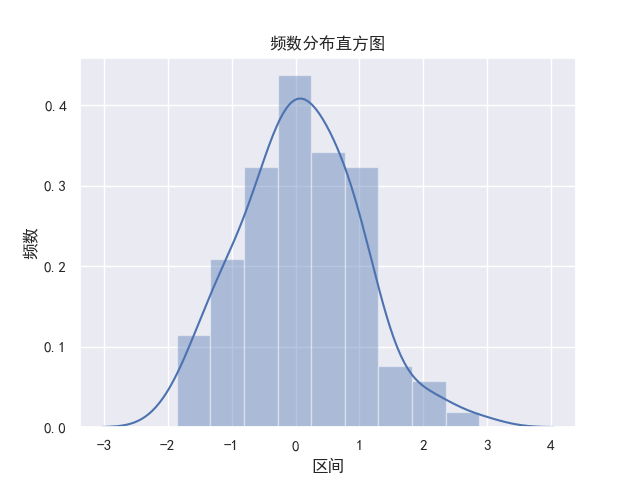



评论 (0)